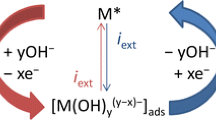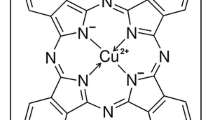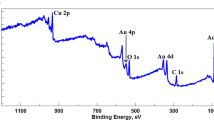Abstract
The general behaviour of potentiostatically grown gold oxide films during the oxidation of phenol in basic solutions has been studied using cyclic voltammetry. No catalytic activity is observed and phenol oxidation is prevented when the oxide film consists of both α- and β-oxides. The depletion of β-oxide is accompanied by rapid electrode passivation, showing that the presence of Au(OH)3 is essential for the oxidation process to take place. A tentative reaction mechanism based on the IHOAM model of electrocatalysis is proposed to account for the participation of the redox mediator couple Au(I)/Au(III).
In solutions having high concentrations of KClO4 or KCl and short reaction times chlorination occurs at gold oxide electrode films, without polymerization at temperatures lower than 308 K and 321 K respectively. Oxidation and chlorination reactions occur with apparent activation energies ofca 17 and 70 kJ mol-1 respectively: this indicates that oxidation is favoured at lower concentrations of the additives.
Similar content being viewed by others
References
A. Savall,Chimia, 1995,49, 23
M. Gattrell and D.W. Kirk,J. Electrochem. Soc., 1993,140, 1534
K. Scott,Proc. Electrochem. Soc., 1994,19, 51
S. Trasatti,Int. J. Hydrogen Energy, 1995,20, 835
L.D. Burke and P.F. Nugent,Gold Bull., 1998,31, 39
L.D. Burke and P.F. Nugent,Gold Bull., 1997,30, 43
G. Jerkiewicz, in ‘Interfacial Electrochemistry’, ed. A. Wieckowski, M. Dekker, New York, 1998
G. Tremiliosi-Filho, L.H. Dall’ Antonia and G. Jerkiewicz,J. Electroanal. Chem., 1997,422, 149
P.I. Iotov and S.I. Kalcheva,Bull. Electrochem., 2000,16, 407
M. Noel and K.I. Vasu, ‘Cyclic Voltammetry and the Frontiers of Electrochemistry’, Aspect Publ. Ltd., London, 1990, p. 223
11 ‘CRC Handbook of Chemistry and Physics’, 65th Edition, ed. R.C. Weast, CRC Press, Boca Raton, USA 1984, D-155
G.H. Kelsall, N.J. Welham and M.A. Diaz,J. Electroanal. Chem., 1993,361, 13
D. Dickertmann, J.W. Schultze and K.J. Vetter,J. Electroanal. Chem. 1974,55, 429
B.E. Conway,Prog. Surf. Sci., 1995,49, 331
S.I. Bailey, I.M. Ritchie and F.R. Hewgill,J. Chem. Soc. Perkin Trans. II, 1983, 645
M. Fleischmann, I.R. Hill, H. Mengoli and M.M. Musiani,Electrochim. Acta, 1983,28, 1545
T.A. Kharlamova and G.A. Teodoradze,Usp. Khim., 1987,36, 29
C. Paliteiro,Electrochim. Acta, 1994,39, 1633
F.A. Cotton and G. Wilkinson, ‘Advanced Inorganic Chemistry’, 3rd Edition,, J. Wiley & Sons Inc., New Yorketc, 1972
L.D. Burke and V.J. Cunnane,J. Electroanal. Chem., 1986,210, 69
L.D. Burke, J.K. Casey, J.A. Morrissey and M.M. Murphy,Bull. Electrochem., 1991,7, 506
L.D. Burke, D.T. Buckley and J.A. Morrissey,Analyst, 1994,119, 841
L.D. Burke, G.M. Burton and J.A. Collins,Electrochim Acta, 1998,44, 1467
A.A. von Mengershausen, S.M. Esquenoni, C.R. Abaca, S.M. Zaniolo, R.A Nocetti and M.G. Susterisic, ‘3rd International Symposium on Electrocatalysis’, ed. S. Hocevar, M. Gaberscek and A. Pintar, Portoroz, Slovenia, September 11–15 1999, p. 153
E. Plattner and C. Comninellis, in ‘Process Technologies for Water Treatment’, ed. S. Stucki, Plenum Press, New York, 1988, p.205
J. Mieluch, A. Sadkowski, J. Wild and P. Zoltowski,Przem. Chem., 1975,59, 513
Ch. Comninellis and A. Nerini,J. Appl. Electrochem., 1995,25, 23
E. Lodowicks and F. Beck,Chem. Eng. Technol., 1994,17, 338
P.J.M. van Andel-Scheffer, ‘Noble Metal Catalysis for the Selective Treatment of Wastewater’, OSPT Projects, Eindhoven, Netherlands, 1995
Author information
Authors and Affiliations
Additional information
Professor Philip Iotov is an affiliate of the University of Chemical Technology and Metallurgy in Sofia. He has worked in the Chemical Engineering, Environmental Engineering, and Fundamentals of Chemical Technology Departments. He obtained his PhD from the Higher Institute of Chemical Technology in Sofia in 1975. Dr Iotov has worked in Tongji University, Shanghai, and The Queen’s University, Belfast on environmental science and engineering topics. His publications are related to the study of catalytic processes, including the effect of potentiostatically grown gold oxide films on the oxidation of phenol in basic solutions: research which is relevant to electrocatalysis and wastewater treatment.
Sasha Kalcheva is also a graduate of the Higher Institute of Chemical Technology in Sofia. She received her PhD in 1975. Later she worked on electrocatalysis with Professors Wolf Vielstich and Joachim Heitbaum in Bonn University. Professor Kalcheva has been involved in extensive investigation of the electrocatalytic oxidation of organic substances.
Rights and permissions
About this article
Cite this article
Iotov, P.I., Kalcheva, S.V. A study on the effect of potentiostatically grown gold oxide films on the oxidation of phenol in base. Gold Bull 34, 95–103 (2001). https://doi.org/10.1007/BF03214820
Received:
Issue Date:
DOI: https://doi.org/10.1007/BF03214820




